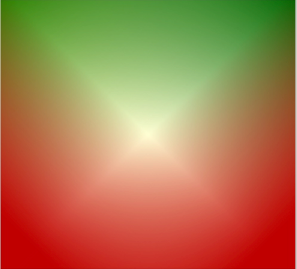I am certain there is a more elegant way to do this. Anyway, here you go: the last line is a pretty close recreation of your original image in the question.
![]()
library(scales)
four.color.matrix <-
function( mycols ){
m <- matrix( NA , 100 , 100 )
m[ 1 , 1 ] <- mycols[ 1 ]
m[ 1 , 100 ] <- mycols[ 2 ]
m[ 100 , 1 ] <- mycols[ 3 ]
m[ 100 , 100 ] <- mycols[ 4 ]
m[ 1 , 1:100 ] <- gradient_n_pal( c( mycols[ 1 ] , 'white' , mycols[ 2 ] ) , values = c( 1 , 50 , 100 ) )(1:100)
m[ 1:100 , 1 ] <- gradient_n_pal( c( mycols[ 1 ] , 'white' , mycols[ 3 ] ) , values = c( 1 , 50 , 100 ) )(1:100)
m[ 1:100 , 100 ] <- gradient_n_pal( c( mycols[ 2 ] , 'white' , mycols[ 4 ] ) , values = c( 1 , 50 , 100 ) )(1:100)
m[ 100 , 1:100 ] <- gradient_n_pal( c( mycols[ 3 ] , 'white' , mycols[ 4 ] ) , values = c( 1 , 50 , 100 ) )(1:100)
a <- gradient_n_pal( c( mycols[ 1 ] , 'white' , mycols[ 4 ] ) , values = c( 1 , 50 , 100 ) )
diag(m)<-a(1:100)
b <- gradient_n_pal( c( mycols[ 3 ] , 'white' , mycols[ 2 ] ) , values = c( 1 , 50 , 100 ) )
for(i in 1:(nrow(m) - 1)){
for (j in 1:nrow(m)) if (i + j == nrow( m )+1){
m[i,j] <- b(j)
}
}
for ( i in 2:50 ){
m[ i , i:(101-i) ] <-
gradient_n_pal( c( mycols[ 1 ] , 'white' , mycols[ 2 ] ) , values = c( 0 , 50 , 100 ) )( i:(101-i) )
m[ i:(101-i) , i ] <-
gradient_n_pal( c( mycols[ 3 ] , 'white' , mycols[ 1 ] ) , values = c( 0 , 50 , 100 ) )( (101-i):i )
}
for ( i in 51:99 ){
m[ i , i:(101-i) ] <-
gradient_n_pal( c( mycols[ 3 ] , 'white' , mycols[ 4 ] ) , values = c( 0 , 50 , 100 ) )( i:(101-i) )
m[ i:(101-i) , i ] <-
gradient_n_pal( c( mycols[ 4 ] , 'white' , mycols[ 2 ] ) , values = c( 0 , 50 , 100 ) )( (101-i):i )
}
m
}
z <- four.color.matrix( c( 'red' , 'yellow' , 'green' , 'blue' ) )
library(grid)
grid.raster( z )
# original question asked for something like this
grid.raster( four.color.matrix( c( 'darkgreen' , 'darkgreen' , 'darkred' , 'darkgreen' ) ) )









